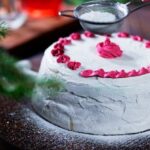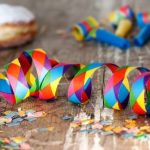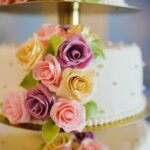Are you looking to learn how to decorate a cake with royal icing? Royal icing is a versatile and classic choice for cake decorating, offering a smooth, elegant finish that can be used to create intricate designs and details.
In this article, we will delve into the basics of royal icing and its use in cake decorating. From preparing the cake and making royal icing from scratch to mastering piping techniques and adding vibrant colors, we will provide you with a comprehensive guide on how to achieve stunning results using royal icing.
Royal icing is a popular choice for decorating cakes due to its smooth texture and ability to harden quickly, allowing for intricate designs and decorations. Whether you’re a beginner or an experienced baker, mastering the art of decorating with royal icing can take your cake creations to the next level.
In the following sections, we will walk you through the necessary tools and materials, step-by-step preparation of the cake, making royal icing from scratch, various piping techniques, adding colors, and tips for troubleshooting common issues. By the end of this article, you will have all the knowledge and skills needed to create beautifully decorated cakes using royal icing.
Whether you’re looking to create elegant borders, delicate flowers, or personalized designs on your cakes, royal icing offers endless possibilities for creative expression. With our detailed instructions and tips for best practices, you’ll be well-equipped to tackle any cake decorating project with confidence. So let’s get started on your journey to mastering the art of decorating a cake with royal icing.
Tools and Materials
Decorating a cake with royal icing requires specific tools and materials to achieve the best results. To start, you will need piping bags and tips in various sizes to create different designs and textures on the cake. Parchment paper or wax paper is essential for practicing piping techniques and creating templates for intricate designs. A good quality offset spatula is also necessary for smoothing and spreading the royal icing on the cake.
In addition to these tools, it is important to have the right materials on hand when working with royal icing. This includes gel food coloring in a variety of shades to achieve vibrant colors for decorating. It is important to use gel coloring rather than liquid coloring, as it will not alter the consistency of the royal icing. You will also need stiff cardboard or cake boards to transport and display the decorated cake.
Furthermore, having a turntable can be extremely helpful when decorating a cake with royal icing, allowing for smooth and even application of the icing. Lastly, make sure to have plenty of clean, dry towels on hand for wiping excess icing off of tools and keeping your work area clean while decorating with royal icing. By having these essential tools and materials ready, you will be well-equipped for successful cake decorating with royal icing.
To ensure that your creativity runs smoothly during this process, gather all these necessary tools and materials before starting your venture into creating beautiful designs using royal icing.
Preparing the Cake
Before you begin decorating a cake with royal icing, it is crucial to ensure that the cake itself is properly prepared. The first step is to level the cake layers, ensuring they are flat and even. This can be done using a long, serrated knife or a cake leveler. Once the layers are leveled, brush off any loose crumbs from the surface of the cake.
After leveling the layers, it is essential to apply a crumb coat. A crumb coat is a thin layer of icing that seals in any loose crumbs, providing a smooth base for the royal icing decorations. To apply the crumb coat, spread a thin layer of buttercream or ganache over the entire surface of the cake. Then, place the cake in the refrigerator for at least 15 minutes to allow the crumb coat to set.
Once the crumb coat has set, you can proceed with applying a final layer of buttercream or ganache to provide an even and sturdy surface for decorating with royal icing. It’s important to ensure that this final layer of frosting is smooth and free from any imperfections before proceeding with royal icing decorations.
| Step | Details |
|---|---|
| 1 | Leveling Cake Layers |
| 2 | Applying Crumb Coat |
| 3 | Applying Final Layer of Frosting |
Making Royal Icing
Royal icing is a versatile and classic choice for decorating cakes and cookies. It is made from powdered sugar, egg whites, and flavoring such as vanilla extract or lemon juice. The key to successful royal icing is achieving the right consistency, which will allow you to pipe intricate designs and decorations onto your cake.
To make royal icing from scratch, you will need the following ingredients: 4 cups of powdered sugar, 3 tablespoons of meringue powder, and approximately 6 tablespoons of warm water. In a large mixing bowl, combine the powdered sugar and meringue powder. Gradually add in the warm water while mixing on low speed until the ingredients are combined. Increase the speed to medium-high and beat the mixture for about 5 minutes or until stiff peaks form.
The ideal consistency for piping decorations with royal icing is when it holds its shape when piped but also slowly incorporates back into itself within 15 seconds. This ensures that your designs will hold their form without being too runny or too stiff.
If the icing is too thick, you can add a small amount of water to thin it out. On the other hand, if it’s too thin, you can gradually add more powdered sugar to thicken it up.
| Ingredients | Instructions |
|---|---|
| 4 cups powdered sugar | Combine with meringue powder in mixing bowl |
| 3 tbsp meringue powder | Mix on low speed while gradually adding warm water |
| 6 tbsp warm water (approximately) | Beat on medium-high speed for about 5 minutes or until stiff peaks form |
Piping Techniques
When it comes to decorating a cake with royal icing, mastering piping techniques is essential for creating beautiful and intricate designs. Here are some common piping techniques used in cake decorating with royal icing:
- Outlining: One of the fundamental piping techniques is outlining, which involves using a thin consistency royal icing to create an outline of the design or shape on the cake. This provides a guideline for filling in with more icing or adding details later.
- Flooding: Flooding is the process of using a slightly thicker royal icing to fill in the outlined area, creating a smooth and even surface. This technique is often used for creating backgrounds or larger areas of color on the cake.
- Creating Intricate Designs: Royal icing allows for intricate designs to be piped onto the cake, such as lace patterns, delicate flowers, or intricate borders. These designs can be achieved by using different piping tips and varying pressure while piping.
It’s important to practice these piping techniques on parchment paper or a practice board before decorating the actual cake to ensure precision and control over the royal icing.
Mastering these piping techniques will allow you to create stunning and professional-looking designs on your cakes using royal icing.
Adding Color
When it comes to decorating a cake with royal icing, adding color can truly bring your designs to life. Here are some tips and tricks for achieving vibrant shades and getting the most out of your royal icing:
1. **Use gel or paste food coloring**: When adding color to royal icing, it’s best to use gel or paste food coloring rather than liquid food coloring. Gel or paste colors are more concentrated, allowing you to achieve vibrant shades without affecting the consistency of the icing.
2. **Start with a small amount**: It’s always best to start with a small amount of food coloring and gradually add more as needed. This will prevent you from accidentally making the color too dark, which can be difficult to lighten once mixed in.
3. **Mix colors for custom shades**: Don’t be afraid to mix different colors together to create custom shades for your designs. For example, combining pink and blue can create a beautiful lavender color, while mixing yellow and red can result in a vibrant orange shade.
4. **Achieve pastel shades with white icing**: If you’re aiming for pastel colors, start with white royal icing as your base. Adding just a small amount of colored gel or paste will result in delicate pastel shades perfect for decorating.
5. **Allow colors to develop**: Keep in mind that colors will continue to develop over time, so it’s best to let your colored royal icing sit for at least an hour before using it for decorating. This allows the true shade of the color to fully develop.
By following these tips and tricks, you’ll be able to add beautiful, vibrant colors to your royal icing and create stunning decorations for your cakes. Remember that practice makes perfect, so don’t be afraid to experiment with different colors and techniques until you achieve the results you desire.
Decorating the Cake
Once you have prepared your royal icing and are ready to decorate your cake, there are various techniques and designs that you can create to make your cake stand out. From simple borders to intricate flowers, royal icing offers a lot of versatility in decorating cakes.
Creating Borders
One of the simplest ways to decorate a cake with royal icing is by creating borders. Using a piping bag fitted with a small round tip, you can pipe lines or dots around the edges of the cake to create a beautiful border. You can also use different piping tips to create different border designs, such as a scalloped edge or a rope-like border.
Making Flowers
Royal icing is also perfect for creating delicate and intricate flowers to adorn your cake. With the right piping tips and techniques, you can make roses, daisies, and other flower designs using different consistencies of royal icing. It’s important to practice these designs on parchment paper before attempting them on the cake to ensure that you have the right technique down.
Adding Intricate Designs
If you’re feeling more adventurous, you can use royal icing to create intricate designs on your cake, such as lace patterns or elaborate filigree. With the right piping tips and steady hand, you can achieve stunning results with royal icing. Remember to start with simpler designs before moving on to more complex ones, as it takes practice and patience to master detailed designs with royal icing.
With these techniques in mind, decorating a cake with royal icing can be both fun and rewarding. Whether you’re aiming for a simple yet elegant design or an elaborate work of art, royal icing provides endless possibilities for creating stunning decorations on cakes.
Troubleshooting
Air Bubbles in the Icing
Air bubbles are a common issue when working with royal icing, especially when using a piping bag. These can result in uneven lines and designs on the cake. To prevent air bubbles, it’s important to properly mix the royal icing and then let it sit for a few minutes to allow any trapped air to rise to the surface.
Before filling your piping bag, gently stir the icing again to release any remaining air. If you still notice air bubbles while piping, gently tap the filled piping bag on the counter to help release any trapped air.
Icing Consistency
Achieving the right consistency of royal icing is crucial for successful cake decorating. If your icing is too runny, it will not hold its shape when piped onto the cake, and if it’s too thick, it may be difficult to work with and create stiff peaks.
To fix runny icing, add more sifted confectioners’ sugar a little at a time until you reach the desired consistency. If your icing is too thick, incorporate a small amount of water or egg white and mix well until you achieve the right texture.
Cracking or Drying Too Quickly
Sometimes royal icing can crack or dry too quickly when decorating, particularly if working in a dry environment or under warm conditions. To prevent this, keep unused royal icing covered with plastic wrap to prevent it from drying out while you work on other parts of the cake.
If you notice cracking while decorating, lightly mist the surface with water using a clean spray bottle or use a small paintbrush dipped in water to smooth out any imperfections without damaging your design.
By addressing these common issues and mistakes when working with royal icing, you can ensure that your cake decorating experience is as smooth and enjoyable as possible. With patience and practice, mastering these troubleshooting techniques will elevate your skills as a cake decorator using royal icing.
Best Practices and Tips
In conclusion, decorating a cake with royal icing can be a fun and rewarding experience. By following the step-by-step guide provided in this article, you can achieve beautiful and professional-looking designs on your cakes. From preparing the cake for decorating to mastering various piping techniques and adding color to royal icing, each step plays a crucial role in creating stunning edible art.
It is important to remember that practice makes perfect when it comes to working with royal icing. Don’t be discouraged if your first few attempts don’t turn out exactly as you had hoped. With time and practice, you will improve your skills and be able to create intricate designs with ease.
Additionally, proper storage and handling of royal icing-decorated cakes are essential for maintaining the integrity of the designs. Keep the decorated cake in a cool, dry place away from direct sunlight or heat sources. If necessary, use a cake box or container to protect the decorations from damage during transportation. Following these best practices will ensure that your beautifully decorated cake stays looking its best until it is ready to be enjoyed.
Frequently Asked Questions
Can You Put Royal Icing Straight Onto a Cake?
Yes, royal icing can be applied directly onto a cake but it’s important to ensure that the cake has cooled completely before doing so. This is because royal icing may slide off a warm cake and not set properly.
Can You Decorate Cakes With Royal Icing?
Royal icing is commonly used for decorating cakes and it can create intricate designs, piping details, and even 3D elements. Its smooth finish and ability to hold its shape make it a popular choice for cake decoration, especially for special occasions like weddings or birthdays.
How Do You Use Royal Icing for Beginners?
For beginners, using royal icing involves learning the right consistency for different techniques such as outlining, flooding, and creating decorative details. It’s essential to practice with piping bags and different nozzle sizes to get a feel for how the icing behaves. Additionally, understanding how to properly color and store royal icing is important for successful cake decorating.

Welcome to my blog about home and family. This blog is a place where I will share my thoughts, ideas, and experiences related to these important topics. I am a stay-at-home mom with two young children. I hope you enjoy reading it! and may find some helpful tips and ideas that will make your home and family life even better!





